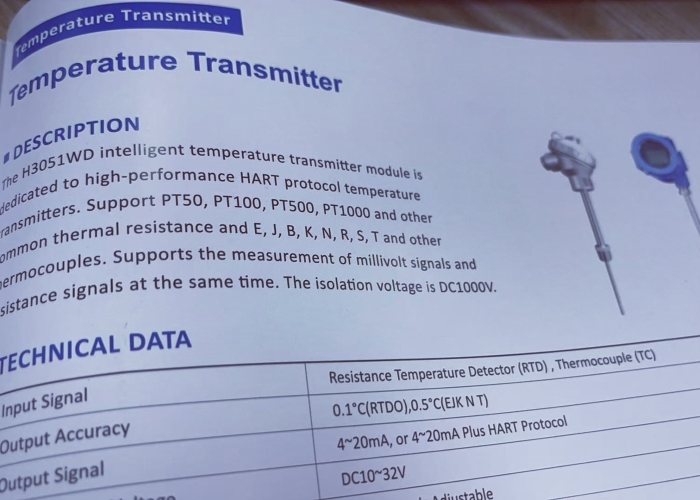
Principle, Classification, and Applications of Temperature Transmitters (Part II)
2025-06-18 13:11How to Select a Temperature Transmitter
1. Measurement Range
Select a transmitter based on the temperature range of your application. For example, a PT100-based transmitter typically covers -200℃ to +850℃, while NTC-based transmitters are suitable for ranges from -50℃ to +150℃.
2. Accuracy Requirements
Choose a transmitter that meets the accuracy requirements of your system. PT100 transmitters can achieve accuracies up to ±0.1℃, while NTC transmitters usually range between ±1℃ and ±2℃.
3. Environmental Conditions
Consider the operating environment when selecting a temperature transmitter. For harsh conditions, look for features such as resistance to high temperatures, corrosion, vibration, moisture, and dust.
4. Price and Cost-Effectiveness
Evaluate both the cost and the overall performance. The most expensive option may not always be necessary; choose one that balances functionality and budget.
Installation and Use of Temperature Transmitters
1. Installation
Install the transmitter at the core of the measured medium rather than on the surface or edge. Ensure proper contact between the sensing element and the measurement point to avoid inaccurate readings due to poor heat transfer.
2. Usage Tips
Keep the transmitter clean and dry. Avoid exposure to corrosive gases or liquids. During operation, minimize vibration and electromagnetic interference to maintain signal integrity.
3. Calibration
Over time, transmitters may drift due to environmental influences. Regular calibration using a known reference temperature source ensures measurement accuracy. Place the transmitter in the same environment as the standard source and compare readings to make necessary adjustments.
Differences Between Temperature Transmitters and Thermocouples
1. Principle
Temperature transmitters convert temperature measurements from sensing elements (such as RTDs or thermistors) into standardized electrical signals (like 4–20 mA or 0–10 V) for remote monitoring or control. They often include signal conditioning and linearization features.
Thermocouples, on the other hand, generate a small voltage directly from the temperature difference between two dissimilar metals joined at one end. This voltage correlates to the temperature and requires interpretation through a transmitter or controller.
2. Measurement Range
Temperature transmitters offer broad coverage depending on the sensing element. For example, RTD-based transmitters range from -200℃ to +850℃, and certain semiconductor-based transmitters extend beyond ±1000℃.
Thermocouples are suited for very high-temperature environments. For instance, copper-constantan types operate from -200℃ to +400℃, while Type J and K thermocouples handle up to +1000℃ or more.
3. Accuracy
Transmitters using high-quality RTDs can achieve accuracies of ±0.1℃ or better. Some even offer ±0.01℃ under controlled conditions.
Thermocouples generally provide lower accuracy—about ±1℃—but remain reliable at extreme temperatures.
4. Response Time
Temperature transmitters with RTDs or thermistors respond quickly—within tens of milliseconds. Advanced transmitters with semiconductor sensors can respond in under 10ms.
Thermocouples usually respond within 1–2 seconds, depending on the construction and protective sheath.
5. Applications
Temperature transmitters are widely used in HVAC systems, industrial automation, food processing, medical equipment, and environmental monitoring. Their role is vital in converting local temperature data into standardized signals for integration with PLCs or SCADA systems.
Thermocouples are preferred in high-temperature industries like metallurgy, petrochemical refining, and furnace monitoring.
Temperature transmitters are essential devices used to convert temperature measurements into standard signals for monitoring and control. They are widely used in industrial automation, environmental monitoring, and medical applications. When selecting a temperature transmitter, factors such as measurement range, accuracy, environmental conditions, and cost should be considered. Proper installation and regular calibration help ensure long-term accuracy and stability. Compared to thermocouples, temperature transmitters differ in principle, accuracy, and application scope, making it important to choose the right type based on specific needs.

